2024–2025


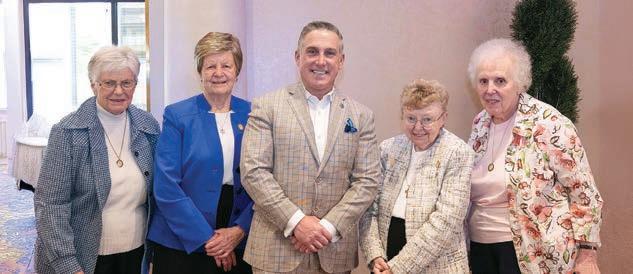
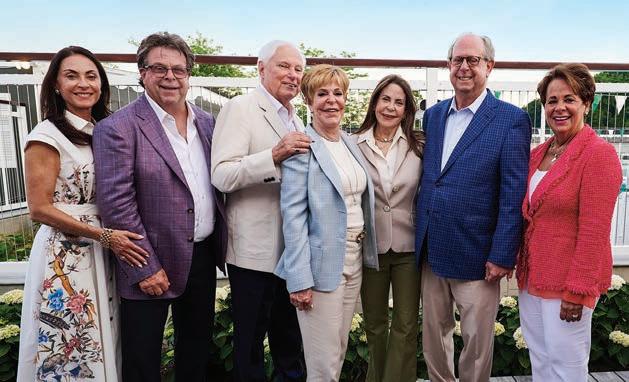
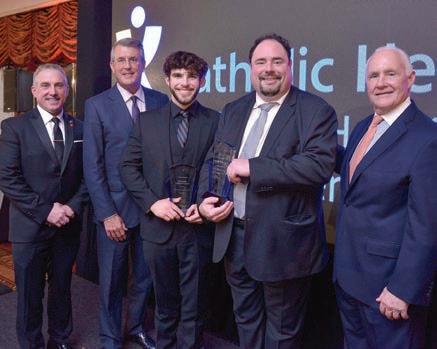
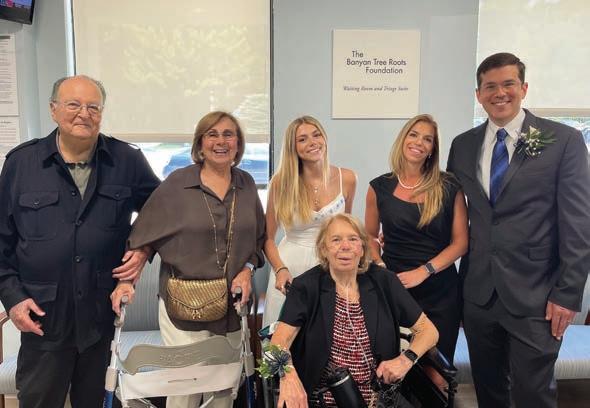
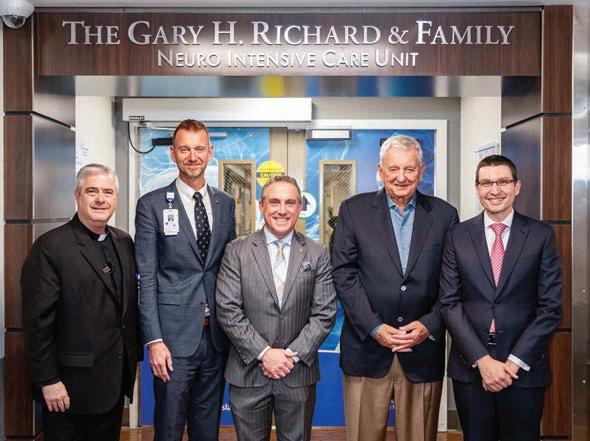
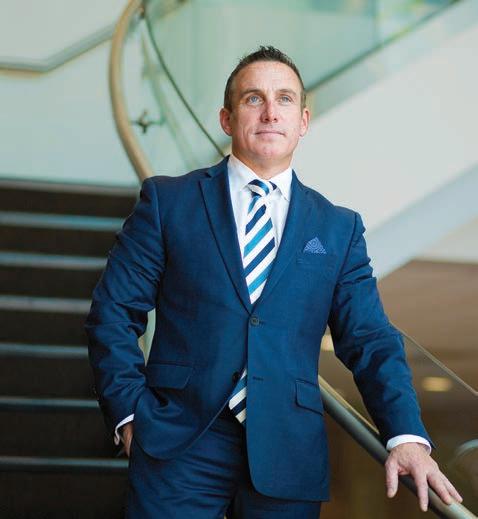









Patrick M. O’Shaughnessy, DO, MBA
I am proud to share our first-ever Catholic Health
Philanthropic Impact Report with you. It truly celebrates all of the areas throughout Catholic Health where philanthropy is making a vital difference.
Whether it’s related to research, innovation, expansion and renovation of space, ensuring dignified end-of-life care, or programs that directly impact patient care and comfort, your commitment to helping your fellow Long Islanders is an indispensable part of our Catholic Health mission.
Thank you for standing by our side with your support and generosity as we care for people all across the Island. Simply put, you make a difference. It’s our passion for excellence—and your steadfast support—that is making Catholic Health the go-to health care system on Long Island.
As you read through this report, you will see the impact of generous giving at Catholic Health. Please accept my sincere gratitude for joining us in our journey. Together, we are shaping the next generation of care.
Thank you for being a part of the Catholic Health family!
At Catholic Health, the journey to healing often begins in the Emergency Department (ED), a place where clinical excellence combines with compassionate care to meet a health crisis.
Across Nassau and Suffolk counties, Catholic Health’s hospitals provide 24/7 emergency care, staffed by board-certified emergency medicine physicians, skilled nurses,
radiologists and dedicated support teams. However, exceptional care is not possible without exceptional facilities. That’s where the power of philanthropy comes in.
In 2024, Catholic Health made bold strides to transform its Emergency Departments, thanks in large part to the generosity of our philanthropic partners. These critical investments are not mere renovations, but


life-saving upgrades that are redefining the emergency care experience for tens of thousands of Long Islanders each year.
St. Charles Hospital:
A $10 million vision realized
In August of 2024, St. Charles Hospital unveiled a dramatic $10 million expansion and modernization of its Emergency Department, adding 4,000 square feet, 10 new treatment bays, enhanced nursing and charting stations, and a significantly expanded waiting room.
This transformation was made possible through a combination of public and philanthropic support, including a $4.2 million grant from the New York State Facility Transformation Program
and significant contributions from community donors. “It was important to us to be part of the Emergency Department project because it will help so many in our community,” said Belle Terre residents Vesna and Tomislav Kundic. “We are very impressed with this new space and happy to support St. Charles.”
Hospital President Jim O’Connor sees the modernization as a pivotal moment, both for St. Charles Hospital and the community it serves. “The St. Charles’ ED expansion enables us to better manage patient flow and address the disparate needs of distinct patients seeking emergency care. That produces a higher quality of overall patient care.”
St. Catherine of Siena Hospital: A community-led renewal
Earlier this year, St. Catherine of Siena Hospital completed a largescale renovation of its Emergency Department, adding upgraded triage and registration areas, larger treatment bays and a modernized waiting room. A new ambulance bay now also ensures faster, more seamless patient transfers.
The renovation was made possible by a matching grant from the Banyan Tree Roots Foundation for community funders to come forward and join them in supporting St. Catherine of Siena Hospital.
“St. Catherine is our community hospital and we loved the idea of helping in whatever way we can,” said Melissa Alfond of the Banyan Tree Roots Foundation. In addition, her husband Kyle said, “I think it’s so important to support your local community and what a better way than through your local hospital. I encourage others to step up and give to St. Catherine.”
Serving approximately 24,000 emergency patients annually, St. Catherine now provides faster, more responsive care, including the advanced cardiovascular services of St. Francis Heart Center, which has been incorporated into St. Catherine of Siena Hospital. This renewed space stands as a symbol of what
philanthropy can accomplish: delivering world-class emergency care within the local community, right where it’s needed most.
Mercy Hospital:
A $6 million leap forward
In partnership with visionary philanthropic supporters Rocco Trotta and the Mother Cabrini Health Foundation, Mercy Hospital unveiled the first phase of its Emergency Department revitalization. This 9,000-squarefoot renovation was purpose-built to reduce overcrowding, speed diagnosis and streamline care for time-sensitive emergencies such as strokes and cardiac events.
Advanced technology, optimized medical workstations and a reimagined patient flow now ensure faster, more efficient and
The enhancements made across Catholic Health’s Emergency Departments are more than just brick-and-mortar improvements— they are investments in people, in neighborhoods and in the future of community health, all of which represent our core mission and values. None of this would be possible without the partnership of generous donors who understand that access to timely, high-quality emergency care can mean the difference between life and death.
By supporting Catholic Health, the philanthropic community is helping to build a stronger, healthier Long Island—one emergency room, one patient and one life at a time.
more dignified care for the 35,000 patients who come through Mercy’s Emergency Department each year.
“The Emergency Room is the first point of contact for thousands of people,” said donor Rocco Trotta. “I am pleased to support this renovation to help accommodate
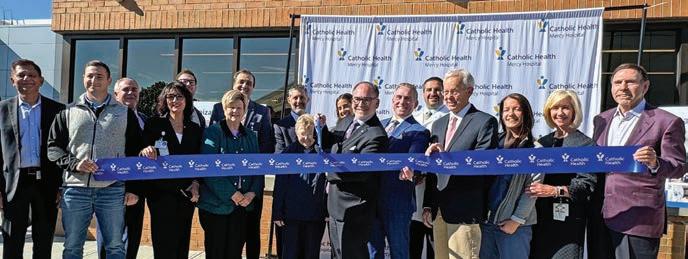
anyone who turns to us in their time of need, in the most caring and warm environment. It makes all the difference.”
“Our partnership with Catholic Health has honored our namesake Saint Frances Cabrini and our mission to improve access to quality health care for the most overlooked, underserved and excluded members of our community,” said Mother Cabrini Health Foundation Senior Program Officer Marc Damsky. “This newly renovated emergency room at Mercy Hospital expands our impact, ensuring that the neediest New Yorkers will receive timely, life-saving care with the respect and dignity they deserve. We are proud to support Catholic Health knowing that this investment will serve so many members of our diverse community.”
Nursing Education and Leadership Funds throughout Catholic Health are enabling nurses to further their education and increase their skillsets, directly impacting the delivery of quality care.
In 2024, Catholic Health made bold strides to transform its Catholic Health-created Nursing Education and Leadership Funds to provide essential funding for training, mentoring and formal education for all levels of nursing staff. Made possible by the Mother Cabrini Health Foundation and many other generous donors, the program has already had a tremendous impact on 166 Catholic Health nurses and aspiring nurses as they work to fulfill their educational ambitions and goals.

Orlin Frances, supporter of St. Joseph Hospital
“ Why I give… My father taught me to give back and to do so with an open heart. St. Joseph Hospital is more than just the place I work—I give back to support my fellow colleagues through the Employee Crisis Fund. I hope if an employee finds themselves in a bind, my giving will help them.”
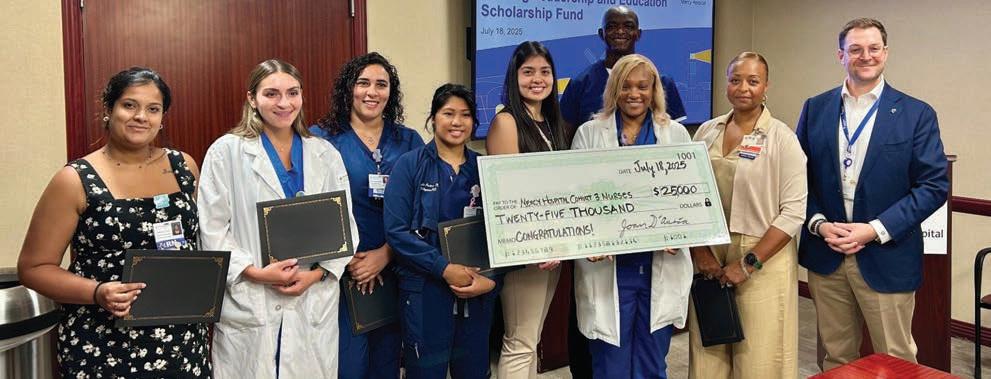
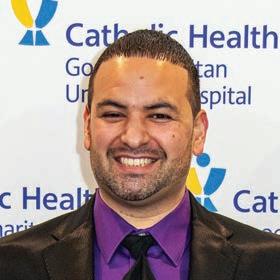
“This is the first scholarship I’ve ever received,” explained Ivan Gonzalez, RN, BSN. Gonzalez began his career as a transporter at Good Samaritan University Hospital. He was inspired by the Emergency Department, and said, “They were like a Formula One team! Every person knew what they had to do and how to care for the patient. I knew that’s where I wanted to be.” Gonzalez is now a Registered Nurse in the Emergency Department. He said he is proud to be a role model for his two children, showing them what it means to set goals and go after them.

Melissa Leon, RN, MSN, achieved her Master’s degree at Molloy University, with help from the Nursing Education and Leadership Fund. She was a Medical Intensive Care Unit (MICU) nurse at Good Samaritan University Hospital. After graduation, she advanced to become a psychiatric nurse practitioner at Mercy Hospital. “I have been with Catholic Health since 2018, going from unit clerk, to nurse and now to nurse practitioner,” said Leon. “I absolutely had to continue working for the same health system. Catholic Health has taught and helped me so much.” Today, she is further investing in her career and education as she prepares to enroll in Molloy University’s Post-Master’s Certificate Program to become an adult-gerontology acute care nurse practitioner. She explains, “With this certification, I will be dual-certified in both psychiatry and acute care, allowing me to provide comprehensive treatment to patients across their full spectrum of needs.” The encouragement Leon received during the program has her thinking about a doctoral degree down the road.
Eric Burke, RN, MBA , is a clinical educator in the Nursing Education Department at St. Charles Hospital, but he began his tenure at the hospital as quality management coordinator in 2018. Prior to that, Eric served as a captain in the U.S. Army for five years where he held positions ranging from a forward deployed tank platoon leader to company commander, leading up to 150 soldiers. In 2014, he earned his Bachelor of Science in Nursing from Stony Brook University. Now pursuing a Master’s in Health Informatics at the University of South Florida, he is the proud recipient of the 2024 Lt. Michael Murphy Foundation Scholarship, created in Murphy’s memory by his family after he died in the line of duty in Afghanistan. They first partnered with Catholic Health last year to further the education of a deserving nurse. Burke said, “As a veteran myself, it’s very meaningful to receive this scholarship.” As fate would have it, Burke is an avid runner and has participated in the annual Lt. Michael P. Murphy Run Around the Lake fundraiser for years before even knowing about the namesake scholarship.

Louis Silverman and his family have been involved with St. Francis Hospital for more than 20 years, starting with his father’s treatment after a cardiac event. Over the years, Silverman was impressed with the nursing staff’s professionalism and compassion. Together with his family, Silverman created the Silverman Nursing Scholars Fund as part of the Endowment for Nursing Leadership & Education to help nurses advance in their careers. “We wanted to give back to the nurses because they give so much of themselves to care for others,” Silverman said. “We’re hoping as the program continues, it can deliver a lot of benefits to those nurses wanting to further their education and leadership skills.”
These nurses, and more, are all grateful for the investment in their education and careers by Catholic Health and the donors whose partnership has enabled the creation of the Nursing Education and Leadership Funds. “Nurses are truly the beating heart of Catholic Health,” said Peggy Maher, Chief Development Officer at Catholic Health. “It is profoundly encouraging to see how keen Catholic Health donors are to show their gratitude toward our nursing professionals across the system.”
Food insecurity is more than a social issue—it’s a serious health concern. People facing hunger are at a much higher risk of chronic illness and often require more frequent and increasingly costly medical care.
Catholic Health has committed to tackling this issue as a top priority. By joining forces with communitybased organizations, Catholic Health is putting its mission into action through a robust, system-wide effort to ensure every patient who enters the health care system is screened for food insecurity, so that help can begin where healing starts. By bringing food insecurity screening directly into all six of its hospital Emergency Departments, Catholic Health identifies those who struggle to put food on the table and connects them with both immediate relief through
“food-to-go” bags provided by its partner Long Island Cares, as well as lasting support through Catholic Charities and the Health and Welfare Council of Long Island, which assists families in enrolling in the federal government’s Supplemental Nutrition Assistance Program (SNAP).
Catholic Health’s program has screened more than 65,000 individuals; hundreds of families have received food and hundreds more have been referred for SNAP assistance.
“I say it all the time … food is medicine,” said Catholic Health President & CEO Patrick M.
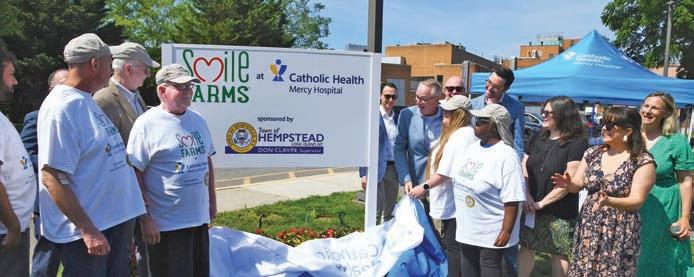
O’Shaughnessy, DO, MBA. “By focusing on food insecurity as a system, we can improve both quality of life and overall health of our communities. Sound nutrition can truly bend the disease curve, preventing many instances of diseases like diabetes or heart disease.”
Supplementing this effort is fresh produce grown in Catholic Health’s three Cooperative Gardens, developed in partnership with Smile Farms. These gardens are designed to support the mental health community, while combating food insecurity on Long Island. The produce is shared with foodinsecure individuals at Mercy Hospital’s Family Care Center.
The farm also provides employment opportunities for Mercy’s behavioral health patients, who tend the garden and earn meaningful wages while giving back to others in need.
“Food insecurity is growing on Long Island,” noted Peggy Maher, Chief Development Officer at Catholic Health. “We are fortunate to have many donors in the community who want to partner with us to make a real difference to our neighbors in need. I offer our sincere thanks for helping us move the needle with our multi-pronged approach to
reach the most amount of people possible.”
Catholic Health has been addressing food insecurity on Long Island since 2017 through a partnership with Island Harvest and Adelphi University. The team collaborated with Catholic Health Home Care to create a program to decrease the risk of chronic disease by providing healthy food to those in need, as well as patient-tailored nutrition and disease-related information. Additionally, through a partnership with “God’s Love We Deliver,” patients were provided meals tailored to their specific health needs. These programs resulted in greatly reduced hospital readmissions and patients reporting a better understanding of the connection between what they ate and their health.
But the work doesn’t stop there. Catholic Health is expanding its reach through innovative community programs, like senior assessment events across Long Island, on-site screenings and diabetes education sessions in partnership with Long Island Cares. No matter where a patient interacts with the system, the message is clear: Access to healthy food is essential to healthy living.
Catholic Health, in partnership with the Mother Cabrini Health Foundation, is helping patients get the necessary medications they need, even if they are uninsured or can’t afford the cost of their medications.
The Meds to Beds Program allows hospital pharmacies to provide prescribed medications to patients as part of their hospital discharge process. Traditionally, patients are discharged from the hospital with a prescription to fill at their local pharmacy. The problem is that many uninsured or underinsured patients neglect to fill their prescriptions due to the costs. The result is often a readmission to the hospital.
For example, if a patient should contract Clostridium difficile (C. diff), it can be easily treated with medication, but the medicine can cost up to $3,000. An uninsured patient would often not be able to afford the medicine at their pharmacy and therefore, wouldn’t get treatment, would get sicker and would return to the hospital. “It’s a vicious cycle,” said Nasser Saad, BS, PharmD, Catholic Health’s Vice President of Pharmacy and Ancillary Resources. “If they don’t take the appropriate medication, patients can end up back in the hospital again and again.”
Meds to Beds enrolls nearly 600 patients, reduces readmission rates by 5% and raises medication refill rates by 5%, too. The program is
Amal Sokkar, supporter of St. Catherine of Siena Hospital
“ Why I give… I support St. Catherine of Siena Hospital because giving is my way to thank God for blessing me with my faith and family. I want to support trusted organizations, like St. Catherine, who will do the right things and help people in need. It’s important for me to leave a legacy hoping that I can make a difference, and hopefully make the world a little better!”
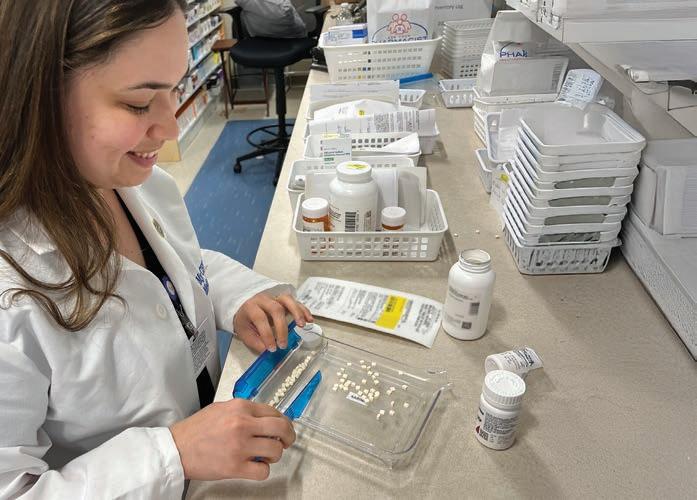
available across Catholic Health, but is particularly well-utilized at Good Samaritan University Hospital, Mercy Hospital and St. Francis Hospital & Heart Center. “As Meds to Beds becomes better known, more people are referring their friends to the program,” said Saad.
Meds to Beds typically provides a 15 – 30 day supply of medications. The hospital pharmacy is listed as the point of contact for refills, so patients can continue to use the medication coverage program. If a patient does not have a fixed address, as is often the case with patients at Catholic Health’s Behavioral Health
Centers, they can pick up their medications when coming to the center to see their physician. Pharmacy staff will even reach out to prescribing physicians to change medications to ones covered by a patient’s insurance. Finally, if a medication is not covered by insurance, Meds to Beds will cover any additional costs.
The Meds to Beds Program is made possible by a generous grant from the Mother Cabrini Health Foundation. With their support, Catholic Health is ensuring its mission to meet the needs of every patient, every time.
Catholic Health’s Legacy Society is a group of grateful patients and supporters who have chosen to give back to Catholic Health, inclusive of its six hospitals, home care, hospice and outpatient services. They do so through thoughtful gift planning, including bequests, charitable gift annuities, retirement fund distributions, gifts of life insurance and more.
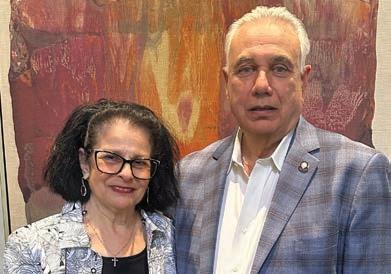
Members of the Legacy Society
William Adams*
Fortuna Adessa*
Frances Amicone*
Belle Amodeo*
Anthony Anzalone*
Michael Apollo
Patricia Astor*
May G. Austin*
Joel S. Balsam*
Lorraine and Barry Bangel
Virginia and Bernard Bartley*
John Beaman*
Millicent and Maurice Bellah*
Marion Benischek*
Ellen J. Benson*
Al and Roseann Campagnola decided to include St. Francis Hospital & Heart Center in their legacy planning because of their long-time experience with the hospital. “My wife and I have prepared our wills and we have included St. Francis, as well as other organizations that are important to us. We believe nothing is more important than providing for future generations. My wife and I are very proud to be members of the Legacy Society,” said Al Campagnola.
Gifts like the Campagnola’s not only help to ensure that Catholic Health’s life-saving work will continue far beyond the lifetime of the donors, they also inspire others to commit themselves to supporting the leading-edge, compassionate and personalized health care that Catholic Health represents. We invite you to learn more about Legacy Society and join fellow Long Islanders in giving back through thoughtful gift planning.
Andrew Berkowitz*
David M. Bernstein*
Raymond Blaszky*
Virginia Bolla
Gerard Bottini*
Emilie Van Bourgondien*
Susan and Tom* Brahms
Joan Brakman
John Brancaccio*
Wilbur F. and Dorothy Breslin
Cleola H. Broere*
Mary J. Brown*
Aniko and Philip* Burzo
Louise O. Butler*
Catherine* and Dom Camera
Roseann and Al Campagnola
Victor A. Canevari*
Doris Cantor*
Lyn and Nick Casale
Barbara Casey*
Robert B. Catell
Daris Chasas*
Esther Chassen*
William J. Christie
Fern and Hersh Cohen
John and Gloria Confort*
Virginia Ann Connors*
Mary V. Cunningham*
Charles S. Daily*
Frances G. Dapper*
Kathleen Davis*
Charles E. DeClerck*
Edna M. Delloiacono*
Thelma J. Demarco*
Nancy and Frederick DeMatteis*
Kathleen and Dan Denihan
Gregor Denning*
Maria DiFasano
James J. Dolan*
Anne Wilson Duerden*
Lilian Ebbitt*
Rose Eletto*
Patricia Ellis*
Carol L. Failla*
Sharon and Michael Falcone
Thomas J. Fanning, Sr.
Gerald S. Fine
Melvin Finkelstein
Barbara Fitzgerald*
Robert and Jacqueline Forman
Carolyn Fostel*
Mary E. Fowler*
William P. France*
Barbara Fredel*
Barry Friedberg*
Susan Friedman-Russo
Harrison and Patricia Fuller
Family Trust
Elizabeth Gaeta*
Maud Gallagher*
Frances B. Garvey*
Geraldine and Leonard Genovese
Eleanor Giammarino*
John Van Gibson*
Edward E. Giles*
Anna M. Gill*
Gertrude Gill*
Bertha Goggins*
Ruth Gold
John J. Gorman*
Hugh M. Graham*
Charles A. Greiner*
Alice M. and Abraham J.* Gross
Mary and Dino Guiducci*
Augusta M. Gulden*
Joan and Leo Haberman*
John and Becky Halleron
Olga V. Hargis*
Martha M. Harr*
Maria E. Harris
Daniel P. Hays*
Theresa Heckman
Gertrude E. Helwig*
Richard D. Hemley
Florence and Edwin Hess*
Alfred B. Heuther*
Caroline and Tim Holden
Lewis S. Hollins*
Giulia M. Honsberger*
William S. and Adele R. Horizon*
Marie G. Hormann*
Mary Howell*
Rosetta Hugo*
Thomas P. Huller*
Patricia Ierardi
Mildred Jacobs*
Catherine F. Jacobsen*
Robert W. Jacobsen*
Marian H. Johnson*
Dorothy Julier*
Emmy M. and Raymond P. Kane*
Marcia Kaplan-Mann
Inge K. Kauders*
Eileen J. Kavanagh*
Margaret Keene*
Chester L. Kelting*
Jane D. Keresey*
Agnes J. Kestner*
Irma Keppler Kiene*
Rose Zimmerman Koehler*
Janet and Jerome* Kroll
Joseph C. Kugler*
Virginia Lack*
Joseph Edward Landy*
Jeffrey A. Lang
Marilyn and Patrick Lanza
Ina* and Larry Lind
Hyman Livingston*
Marie Logothetis*
Patricia Lopiparo
Gabriella Losasso*
Grace H. Lovatt*
Francis Lyle Lunson
Catherine T. Maas*
Anne Maione
Yvette and Joel Mallah*
Gloria Marsloe*
Frances Florence McCarthy*
Herbert J. McCooey
Robert C. McCormick, MD*
Margaret McDevitt*
Arlene* and John McGrotty
Virginia McGuire*
Donald G. McKeon*
Nora Meade*
Riva Metcalf
Selma R. Miller
Irma M. Monahan*
Victor T. Mouillerat*
George A. Mulligan*
Nancy K. Munson*
Allen E. Murray*
Dolores Musto*
Kenneth Myslicki*
Francis Neilson*
Allene B. Newins*
Horace D. Newins
Peter L. Nolan*
William and Jacqueline O’Brien
Mary Carolyn O’Connor*
Nina P. Oliva
Frank J. Ollari*
Lawrence Orilia*
Vito Parisi*
Kathleen C. Peer*
Louise Perotta
William Peterman*
Emilia and Daniel Petrasek
Paul A. Pezar*
Susan Bell Phelps
Arlene Pinkus*
Brian M. Poissant
Joseph A. Pollicino*
Linda L. Pons
Kay Porter*
Charlie and Meg Prato
Dorothy E. Pullis*
Frank Quattrocchi*
Regina Quick*
Katherine L. Renzulli*
Maria Richard *
Lindsey J. Rockwell*
Florence Rose*
Benjamin J. Rosof*
Carmen Russo*
Rosemarie Russo*
Nancy Russo-Rumore
Michael J. Ryan*
William F. Ryan*
Henry E. Salzhauer
B.M. Sandman*
Anthony Santasine*
Anne T. Schwab
Laura Schweber*
Joan Durso Serra
Henry H. Shepard*
Edward E. Shorin*
David H. Smalbach
Margaret F. Smith*
Ronny Soderstrom*
Werner Sonn*
Thomas L. Spadaro*
Sonja Caron Stein*
Lotte and Murray
Steingart*
Charles W. Steinmetz*
Frank Strnad*
Sylvia and Howard Swanson*
Agnes G. Szemere*
Iracema Talbott
Gerald Tambasco*
James M. Taylor*
Peter Tedesco*
Kathryn Z. Teigland*
Hugo Todebush*
Jacqueline TommasoPolon*
Anne Marie Troiano*
Robert Typermass
William P. Urig
Judith Van de Walle
Dorothy VislockySteigerwald*
Joan and Robert F. Vizza
Caroline T. Voege*
Rose M. Volpe*
John F. Wagner*
Margot and Kenneth Walker
Eleanor Wetzel*
Gabriel Wiesenthal
Thomasena Wimmer*
Eugene D. Zanger*
Patricia and Domenico* Zuzzi
Catholic Health held its annual Spring Lunch & Learn in May featuring an interactive panel discussion that explored plans to enhance lifestyles, protect loved ones and provide a purposeful legacy. Moderated by Lyn and Nick Casale, Chairs of the Legacy Society, the panel featured both advisors and individuals who talked about what it means to plan with a purpose.
Later in August, members of the Legacy Society were invited to the annual reception to celebrate their impact on Catholic Health. Dr. Bhoomi Mehrotra, Chair of Cancer Services at Catholic Health and Director of The Cancer Institute at St. Francis Hospital, gave a special presentation about the role of philanthropy at Catholic Health.
We look forward to seeing you at our events next year! To learn more, please contact development@chsli.org or call (516) 563-7950.

L-R: Nick and Lyn Casale, Legacy Society Chairs; along with along with Dr. Bernadette D. Curry, board member of Catholic Health Home Care; Al Campagnola, Legacy Society member; Robert Votruba, Partner of Wealth Management, National Financial Network, Inc.; Stephanie M. Alberts, Esq., Partner, Forchelli Deegan Terrana, LLP
*Deceased
Catholic Health and its entities hold fundraising events throughout the year to both celebrate our patient-focused health care and raise valuable funds to support our hospitals. From golf tournaments to gala dinners and everything in between, thousands of people come together to partner with us and further our mission of excellent health care. We look forward to you joining us at one of our many events next year!
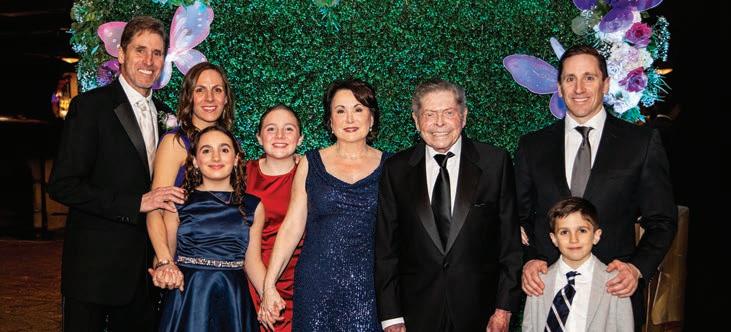

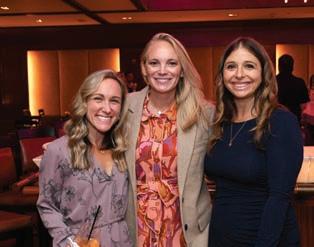
1: 2024 Good Samaritan Gala Honoree Jamie Winkler (center), with her family
2: 2024 Good Samaritan Golf Classic Samaritan’s Cup Winners: Fred O’Meally, Kevin Gershowitz, Michael Lessing and Dr. Justin Lundbye, President Good Samaritan University Hospital with Golf Classic Chair Dr. Anthony Guida
3: Justine Campasano; Brittany Handelson, Good Samaritan Hospital Foundation Board Member; Amanda Barbara Hessian at the Golf Classic cocktail reception and awards dinner
1: Rich Brown; Chris Nelson, President of St. Catherine of Siena Hospital; Joe Manopella, President of Mercy Hospital; Nick Greco at the Mercy Hospital Foundation Golf Classic
2: TJ Murray, President of Friends of Mercy; Dr. Marc DiSciullo, past president of Friends of Mercy; Mike Boranian, Esq., past president of Friends of Mercy; Ari Klonsky, Esq.; Dr. Xenophon Xenophontos, past president of Friends of Mercy at the Friends of Mercy Luau
3: United States Marines Color Guard at the Friends of Mercy Ball

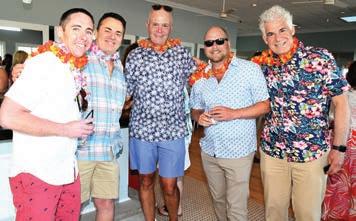
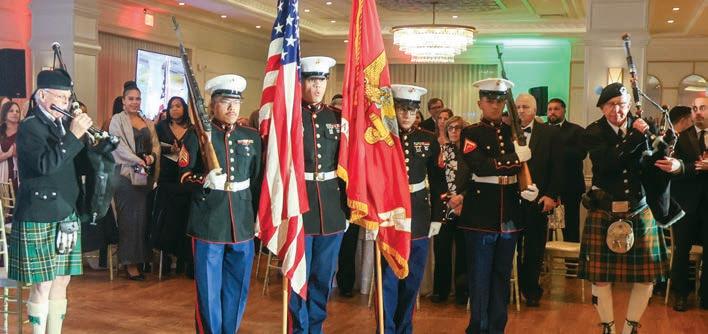

1: Honorees Al Conti and Donna Napolitano-Conti (third and fourth from the left) and their family, at the St. Catherine of Siena Hospital Foundation Gala
2: Charles Schembri; Laura Racioppi; Michele Dean, St. Catherine of Siena Hospital Foundation Board Member; and Frank Trotta, all from Suffolk Credit Union, at the St. Catherine of Siena Hospital 23rd Annual Golf Classic
3: Stephen Piscitello; Bryan Bacarella; Frankie Vega; Matthew Acerno, St. Catherine of Siena Hospital Foundation Board Member, all from Nosh Kitchen & Cocktails and Ciro’s Pizza Family Restaurants, at the St. Catherine of Siena Hospital 23rd Annual Golf Classic
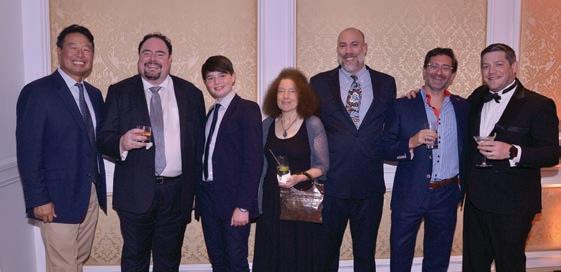




St. Francis Hospital & Heart Center
1: Dr. Stefan Muehlbauer, Honoree and Chair of Emergency Department (second from left) and his guests at the St. Francis Hospital Foundation Gala
2: Crisler and Peter Quick with Dr. Charles Lucore, President of St. Francis Hospital & Heart Center, at the St. Francis Hospital Foundation Gala
3: Tom Fanning, St. Francis Hospital Foundation Chair (second from right) and his guests at the Meadow Brook Club at the 50th Annual St. Francis Golf Classic
1: John Fitzpatrick, Chair of the St. Charles Hospital Foundation Board; Mike Ryan; Al Schefer and NYS Assemblyman Michael Fitzpatrick, at the St. Charles Hospital Foundation Golf Tournament
2: Lt. Michael P. Murphy Memorial Scholarship Presentation at St. Charles Hospital Gala with Dr. Patrick O’Shaughnessy, Catholic Health President & CEO; Jim O’Connor, President of St. Charles Hospital; Eric Burke, recipient of scholarship; Dan Murphy, father of Lt. Michael P. Murphy and founder of the scholarship, and his wife, Karen Murphy, at the St. Charles Hospital Foundation Gala

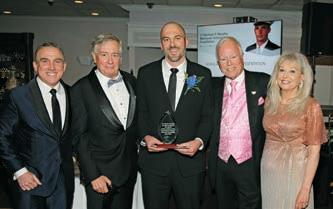


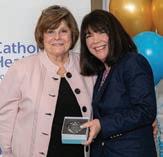
1: Sr. Patricia Moran; Sr. Mary Louise Kelly; Sr. Dolores Castellano; Sr. Mary Pius Marron; Sr. Catherine Artale; Sr. Mary Jocelyn Panzetta and Sr. Helen Kearney from the Congregation of the Infant Jesus, Community Award Honoree, at the Good Shepherd Hospice Brunch
2: Robert Fabio (fifth from the left) and family at the Good Shepherd Hospice Annual Brunch
3: Laura Page-Greifinger, Testimonial Speaker and Kim Kranz, President of Good Shepherd Hospice, at the Good Shepherd Hospice Annual Brunch
When Good Samaritan University Hospital opens its much-anticipated Patient Care Pavilion later this year, the six-story facility is sure to raise patient care on the South Shore to a new standard. The modernization is part of Good Samaritan’s continuing commitment to providing the highest level of care using the most advanced health care technologies and services. It will provide patients with more private space, larger and enhanced clinical areas and closer access to key services within the hospital.
The Patient Care Pavilion adds 300,000 square feet to the hospital campus, including a surgical pavilion with 16 new high-tech operating rooms, 36 new private patient rooms and a modern Emergency Department that spans the first floor
of the Pavilion. The Emergency Department includes 75 comfortable, private treatment bays, helping Good Samaritan handle almost 90,000 patient visits each year—consistently the second highest in Suffolk County.
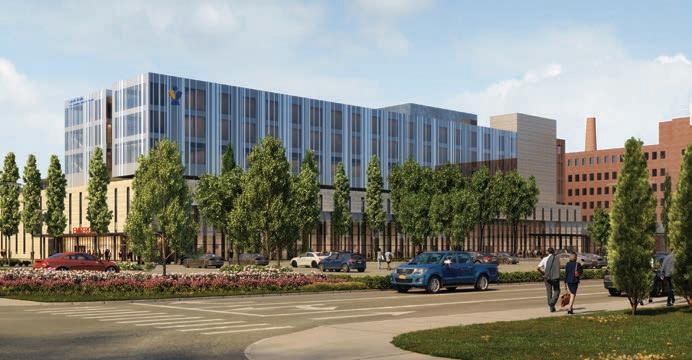
The new Emergency Department will continue to provide world-class care as a Level I Trauma Center for adults and Level II Trauma Center for Pediatrics. “The new Emergency Room is the crown jewel in the new Patient Care Pavilion,” said donor Victor Ganzi, Chairman Emeritus of PGA Tour and Retired CEO of Hearst Corporation. “I believe better emergency care paves the way for better patient care and outcomes throughout a hospital.”
The Ganzi Family decided to support the construction of the Emergency Department and issued a landmark challenge match to the community for others to step up and support the new construction. Many residents have joined the
Ganzi Family in their support of Good Samaritan’s emergency services. There is also a separate space for a dedicated Pediatric Emergency Room with 12 private treatment rooms, pediatric triage space and a pediatric waiting room. The new Del Vecchio Family Foundation Pediatric Emergency Room at Good Samaritan will be staffed by pediatric and child life specialists and will further support the hospital’s role as the only Level II Trauma Center on the South Shore for pediatric patients.
“My family and I decided to dedicate this space in memory of my father, Carmen Nuzzi,” said donor Debra Del Vecchio. “As a cooling and heating specialist, his contract with
Charles and Jeanine Ferraro, supporters of Good Samaritan University Hospital
“ Why we give… Supporting Good Samaritan University Hospital is a deeply personal choice for my wife Jeanine and I. We’ve seen firsthand how compassionate health care can transform lives and we believe strongly in the power of community. Our experiences at Good Samaritan revealed the unwavering commitment of their staff and the exceptional care they deliver each and every day.
This donation is our way of saying thank you and investing in the future of health care for our neighbors and loved ones. We’re proud to help Good Samaritan continue to thrive, knowing it’s a cornerstone of health, hope and healing for our community and beyond.”
Good Samaritan brought him to the campus regularly. His business helped maintain the plant at Good Samaritan, and I know my dad would have loved that we are honoring his memory by supporting children and their families in need of medical attention.”
The carefully designed space follows best practice guidelines to provide optimal care of critically ill and injured children. The use of color and a calming decor will create a welcoming, child-friendly environment for healing care.
“Good Samaritan has always played a key role in helping local residents to recover their health. With the new state-of-the-art Emergency Department, including the special touches provided in the Pediatric Emergency Department, Long Island residents will benefit even further from the care provided at Good Samaritan University Hospital,” shared Sal Capitano, who together with his wife Marie, dedicated the nursing station in the new Pediatric Emergency Department.
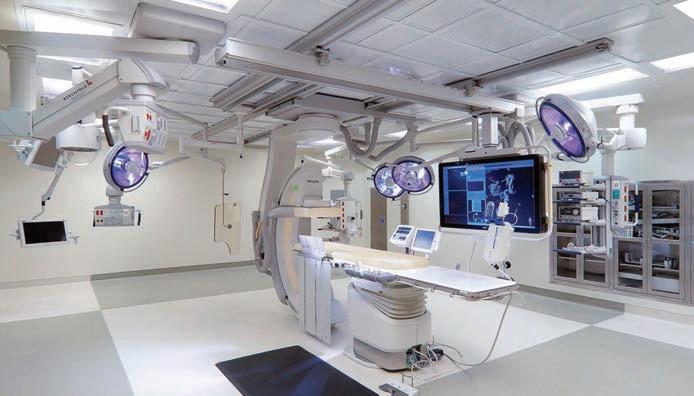
The Patient Care Pavilion is the largest capital investment in Good Samaritan’s history. When it opens, it will help shape the future of health care throughout the immediate community and beyond.
For more than 65 years, Good Samaritan University Hospital has cared for generations of families with compassion and excellence. As we look ahead, we remain deeply committed to those we serve and dedicated to delivering the high-quality care our patients deserve. Our goal remains clear—to be the most trusted health partner for every individual and family who depends on us.
The 300,000-square-foot Patient Care Pavilion also provides other enhanced services, including:
• Dedicated Emergency Department spaces for adults, pediatrics, trauma and behavioral health patients, making the patient experience more efficient, private and comfortable.
• 36 new private patient rooms, each with private bathrooms and a comfortable, spacious design.
• An easy-to-navigate lobby entrance.
• Modern, home-like amenities to help patients focus on healing.
• A distinctive surgical pavilion with 16 new high-tech operating rooms and adjacent pre- and post-care.
• The latest imaging equipment.
Good Samaritan University Hospital has long been a leader in treating strokes and brain aneurysms. It is the first on Long Island to be recognized by both the Joint Commission and New York State Department of Health as a Comprehensive Stroke Center and has cared for more than 7,000 people since it opened in 2018.
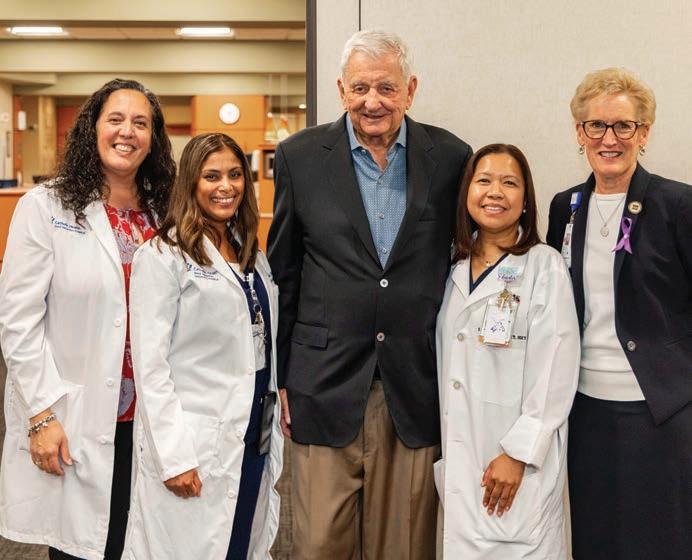
Its future growth and advancement has been greatly reinforced by Gary H. Richard and family, with a historic gift to rename the Center as the Gary H. Richard and Family Stroke & Brain Aneurysm Center.
“I know personally how crucial it is to have qualified specialists on demand and at your bedside,” said Richard, a long-time South Shore resident and business leader. “My family has been blessed for decades to be a part of the Long Island community. It is with our deep, personal and sincere gratitude to have this great opportunity to support the Stroke & Brain Aneurysm Center at Good Samaritan University Hospital.”
The Stroke & Brain Aneurysm Center is under the leadership of Dr. Kimon Bekelis, Chairman of Neurointerventional Services for Catholic Health and Medical Director of the Gary H. Richard and Family Stroke & Brain Aneurysm Center of Long Island. The Center treats the most complex stroke cases by combining the most advanced imaging capabilities in the area, including a 512-speed
low-dose CT scanner, a bi-plane angiography system and the experience and skill of specialized neurointerventionalists, neurointensivists and intensive caretrained nurses and support staff.
The gift from Richard and family allows the Center to expand and enhance its surgical space and invest further in technologies for the future of neurological care. The hospital is also constructing a bi-plane room to accommodate more patients and provide even greater care to the community. The Neuro Intensive Care Unit at Good Samaritan, which is the inpatient unit where much of the Center’s work happens, also reflects the Richard family name.
“We are both humbled and inspired by the gratitude and generosity of our patient philanthropists,” said Dr. Bekelis. “Gary Richard personifies this spirit of selfless contribution that creates an evergreen support of our program and will impact many patients’ lives for generations to come. We are honored that our center carries his family name.”

Brittany and Clint Handelson, supporters of Good Samaritan University Hospital
“ Why we give… When we welcomed our daughter Claire into the world at Good Samaritan University Hospital, our lives changed in ways we could never have anticipated. The sudden need for an emergency cesarean was daunting, but the exceptional care and compassion from the entire staff made that experience not only manageable, but truly peaceful. After spending time in the NICU, we felt incredibly supported and empowered as new parents, and for that, we are forever grateful. We give to Good Samaritan because we want to honor the amazing NICU team who helped us through one of the scariest moments of our lives and equipped us with the confidence to embrace parenthood. As our family has grown, our relationship with the hospital has grown as well. Our philanthropy is our way of expressing gratitude for the profound impact the hospital has had on our family.”
Staying healthy is important for anyone, but it’s especially crucial for expectant mothers. A program at Mercy Hospital is helping high-risk pregnant women to bring their babies to term with the proper support.
The program called “Tele-Mommies” is made possible with support from philanthropic partners including the TD Charitable Foundation, the Mother Cabrini Health Foundation, the Marilyn Lichtman Foundation and others. The Tele-Mommies

program was launched in 2021 at Mercy Hospital and expanded to Good Samaritan University Hospital in 2023.
Mercy Hospital has many patients within its Maternal Fetal Medicine practice who are considered to have high-risk pregnancies. This includes mothers with diabetes or gestational diabetes, chronic high blood pressure and preeclampsia.
“Conditions like diabetes can be managed with healthy foods and tight glucose control, but not all patients have the knowledge or ability to track their glucose or look for other symptoms,” said Christopher Cells, Vice President of Ambulatory Services and Business Development at Mercy Hospital. “It can be hard for them to maintain a supportive environment outside of the doctor’s office.”
Also, frequent office visits are not a practical option for a lot of patients, as many are of limited
means. While there is a bus stop right outside the center, it only comes once every five hours and private transportation options can be prohibitively expensive.
Telehealth for Mommies
With the Tele-Mommies program, these high-risk mothers-to-be receive a package which has a 4G-enabled tablet and Bluetooth enabled devices, including a glucometer, a blood pressure cuff, a pulse oximeter and a scale. They use these tools to monitor their vitals at least once per day. If they forget to check their blood sugar, they will get a reminder. If they miss four glucose monitoring sessions, a nurse will call them to check in. High-risk patients with diabetes also receive help from a diabetes educator to encourage healthier diet and lifestyle choices.
The data collected is sent to a central monitoring station staffed by a Mercy telehealth nurse. If any of the vitals come
back abnormal, the nurse will contact the patient’s OB/GYN. If something seems urgent, they will contact the patient directly.
“Through the Tele-Mommies program, we’ve seen transformative outcomes for underserved, highrisk pregnant women who live in communities facing significant health care access issues,” said Dr. Barra Allaf, Chief of Maternal Fetal Medicine at Mercy Hospital and Interim Chief of Maternal Fetal Medicine for Catholic Health. “Daily remote monitoring, combined with direct support from one of our nurses, has drastically reduced emergency hospitalizations and improved maternal and infant health.”
New this year to the program are the inclusion of a patient navigator and expansion of services to include the postpartum period.
Patients can now access a culturally competent patient navigator who guides them to effectively use the vital signs devices. The navigator also helps schedule appointments, coordinate transportation and fill medical prescriptions.


The Tele-Mommies program is also extending patient monitoring into the first three months postpartum when support may be more limited. This time period can still pose dangers to high-risk patients—for instance, a type 2 diabetes patient may experience the stress of new motherhood along with hormonal changes that can spike her blood sugar and insulin resistance. This can lead to a greater risk for postpartum depression, which affects 10% to 15% of new moms. Historically, Black and Hispanic women—a high percentage of Mercy’s patient population—are significantly less likely to initiate and continue
postpartum depression care, so this type of built-in monitoring can save lives.
Josh Miller-Myers, Corporate Citizenship Manager at the TD Charitable Foundation said, “We are so pleased to partner
with Mercy Hospital to care for our community. Together, we are ensuring that every mother in Mercy’s care has access to the continuous support and quality health care she deserves.”
Joan D’Auria, supporter of Mercy Hospital
“ Why I give… I support nursing at Mercy Hospital through the Sr. Mary Grace Scholarship Fund and the Nursing Education & Leadership Fund. These men and women are front-line caregivers and investing in their education is investing in the future of the nursing profession. I know that they will, in turn, use their newfound skills to further their patients’ experiences at Mercy Hospital.”
The Friends of Mercy Hospital, which began over 90 years ago, is a non-profit organization with a mission to support Mercy Hospital. Since 1935, the Friends have volunteered their time and talent to support the advancement of medical and surgical care for all who turn to Mercy Hospital for their medical needs. Their events are renowned across Long Island and include the Gentlemen’s St. Patrick’s Dinner, 9 & Dine, Luau, Golf Outing and the annual Mercy Ball.
“We are so proud of our work to provide significant funds to Mercy Hospital,” said TJ Murray, President of the Friends of Mercy. “We have provided the hospital with upgraded equipment for the radiology department, renovations to the hospital cafeteria, renovations to the women’s imaging center and much more— and that’s only in the last few years!
The Friends of Mercy are proud of our role in Mercy Hospital’s ability to care for the community.”
Hospital President Joe Manopella works closely with the Friends, remarking, “We estimate that the Friends of Mercy have contributed more than $35 million since their inception. They are directly responsible for many of the

improvements we’ve made to our facilities and equipment. We can’t thank them enough for their hard work and determination.”
Although the members of the Friends focus first and foremost on raising funds to support the facilities, programs and services at the hospital, a ripple effect of their membership are the many deep and meaningful friendships they gain with each other. “The Friends are truly a community of caring individuals who come together to make a real difference to the communities that Mercy serves,” said Murray.

John and Linda Sardone, supporters of Mercy Hospital
“
Why we give… We have been cared for by Mercy Hospital nurses and doctors for many years, going all the way back to our late parents. The care we receive has always been wonderful and the nurses are angels! We are proud to give back and support Mercy Hospital, as it cares for so many people at their most vulnerable time. Mercy is one of the area’s pillar institutions and we want to be part of helping it continue to serve the community for years to come.”
St. Catherine of Siena Hospital brings outstanding care to families in and around Smithtown. With over 11,000 hospital admissions and nearly 24,000 Emergency Room visits annually, the hospital is an important fixture in the community, providing excellent clinical care as well as heartfelt compassion and support for its patients.
With the newest investment in one of its three operating rooms, St. Catherine of Siena will do even more. Operating Room 3 (OR 3) is being expanded to accommodate complex spine surgeries. Soonto-be 60% larger, the expansion will provide physicians and staff the room they need to perform complex surgeries more comfortably. These include surgeries to address degenerative
disease, spinal fusion, trauma, tumors and more. The investment in OR 3 also includes the installation of state-of-the-art intraoperative imaging, allowing for real-time imaging during procedures to increase surgical precision and improve patient outcomes.
The expansion of OR 3 is part of a larger development—that of St. Catherine becoming a Center for Spine and Orthopaedics. The hospital recently welcomed five fellowship-trained, board-certified orthopedic spine surgeons from Long Island Spine Specialists, PC (LISS). The highly recognized team has extensive experience in all spinal conditions and is now based at St. Catherine of Siena Hospital.
Al Conti, a board member of the St. Catherine of Siena Hospital Foundation who both chaired the hospital’s 23rd Annual Golf
Tournament and served as Gala honoree along with his wife Donna Napolitano-Conti, is particularly proud of the new developments. “We decided to dedicate all of our event proceeds to renovating OR 3 because we understand how important it is that we bring this great service to our community. The need for more complex spine surgery space in our area is clear and we are thrilled to have played a part in it.”

Cathy Creighton, supporter of St. Catherine of Siena Hospital
“ Why I give…
My husband and I donate to St. Catherine of Siena Hospital as an investment in the health, strength and stability of our community. It also expresses our personal gratitude for the excellent and compassionate care our family members have experienced over the years. As a foundation board member, I see firsthand how donations are allocated to specific projects. St. Catherine keeps getting better and better, and we are glad to be part of this essential community lifeline.”
The Stephen B. Gold Dental Clinic at St. Charles Hospital has a 100-year history of caring for the underserved, starting with the children with disabilities who were the hospital’s earliest patients. Today, the clinic manages more than 6,000 visits per year, offering a full range of dental services including exams, cleanings, fillings, urgent care and dentures.
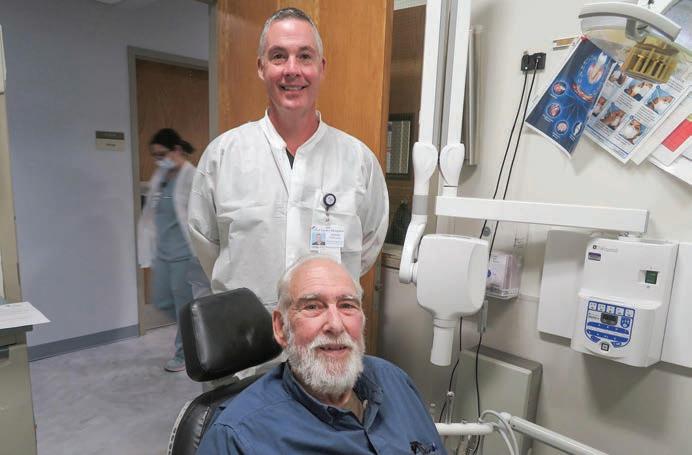
Dental hygienist James Caldroney, RHD and patient Arthur Schnittger at the Stephen B. Gold Dental Clinic
About half of the dental clinic’s clients have physical and developmental disabilities, and the clinic also cares for underserved and underinsured children and adults; priests and sisters of the Diocese of Rockville Centre; and also military veterans. While veterans are supported year round by the clinic, there are semi-annual “Give Vets a Smile” days, offering free dental care.
Suffolk County is home to more veterans than any other county in New York State, which is why the “Give Vets a Smile” days are so well attended—and needed. Former Marine Corps sergeant and Vietnam veteran Charles Rogovitz of Babylon Village avoided seeing a dentist for 25 years because he couldn’t afford the high cost. As some of his teeth became loose over the years, he removed them himself, ultimately
settling for a soft food diet—until he was introduced to the “Give Vets a Smile” program. The clinic was able to provide two lower dental implants allowing him to use dentures that easily snap in and out.
With about half of the client population having developmental and intellectual disabilities, the Stephen B. Gold Dental Clinic understands the critical importance of its work. “Private dental practices do not typically treat patients with developmental and intellectual disabilities,” said St. Charles Hospital President Jim O’Connor. Further, many people in this population shy away from visiting the dentist, afraid of dental care that requires anesthesia and sometimes unable to articulate what they are feeling during an appointment. According to Keri Logan, DMD, Director of the Department of Dentistry, “Proper
John and Mary Fitzpatrick, supporters of St. Charles Hospital
“ Why we give… The sense of community and the culture at St. Charles Hospital is beautiful. They have been such a big part of our lives for generations. Both of our parents were treated at St. Charles many years ago and still today, they tend to the big and small emergencies in our family. We are grateful and proud to support them.”
dental care for the dental clinic’s patients with developmental or intellectual disabilities can make a difference in their overall health. Dental problems are more common in those with developmental and intellectual disabilities, and poor oral health is linked to a greater risk for diabetes and heart disease.”
Because the dental clinic is located within St. Charles Hospital, Dr. Logan and colleagues can easily converse with medical staff about needs that patients may have.
As the Stephen B. Gold Dental Clinic continues to serve its patients, it also has begun expanding for the future through planned construction, doubling its size with the addition of four new dental operatories designed to improve workflow and enhance patient comfort with the latest in dental technology. These additions will
allow the clinic to serve more patients daily while reducing wait times and enhancing the overall care experience. Additionally, the expansion will allow for the onboarding of new dental residents. This critical expansion is being made possible by philanthropy, including a generous grant from the Mother Cabrini Health Foundation as well as the proceeds from the hospital’s 2024 Golf Classic.
“We’re thrilled to grow not just in size, but in our ability to make a greater impact,” said Dr. Logan.
“This expansion means more access for the underserved in our community and more opportunities for the dental residents to gain realworld experience in providing care to our most vulnerable populations. This is truly what it means to live the Catholic Health mission.
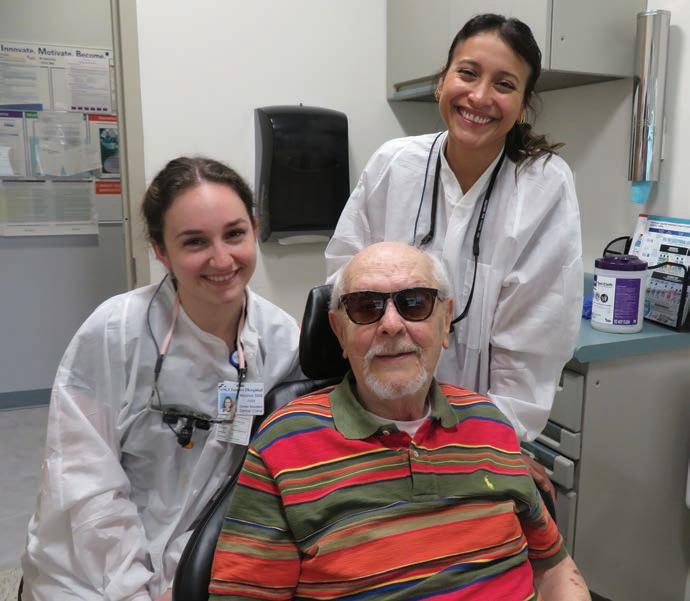
St. Charles Hospital was founded in 1907 by four sisters of the Order of the Daughters of Wisdom who committed to caring for 27 children with disabilities. Now more than 118 years later, St. Charles Hospital is a 243-bed community hospital, serving the residents of the Three Village area. Yet that only tells half the story.
St. Charles Hospital has become a Center of Excellence in Rehabilitation. Today, the St. Charles Hospital Physical Medicine and Rehabilitation Center stands as a program of distinction on Long Island, caring for patients who have endured a major medical crisis or accident, helping them to take back their lives. The center treats adults and children with
traumatic brain injury, stroke and trauma from accidents or falls, physical and developmental disabilities such as amputation or cerebral palsy, along with many other injuries and disorders.
Accredited by CARF International (Commission on Accreditation of Rehabilitation Facilities), the program stands as the largest and most highly accredited acute
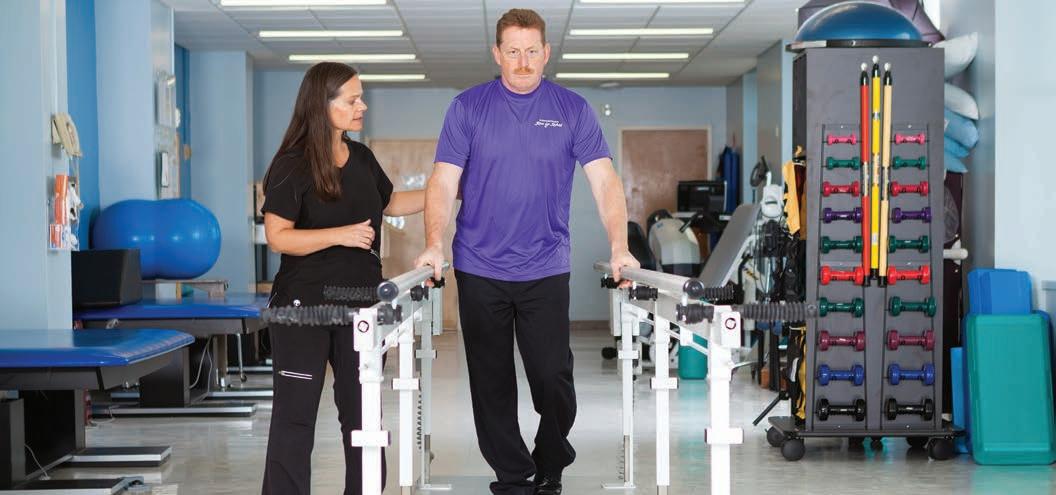
care rehabilitation program on Long Island and is also home to Long Island’s only Pediatric Acute Inpatient Rehabilitation Unit and Pediatric Traumatic Brain Injury Unit. The 76-bed adult inpatient acute care program maintains a waiting list year-round, treating the most critically ill and injured patients. Complementing St. Charles’s inpatient programs, Catholic Health offers physical therapy and rehabilitation at 10 sites across Long Island, accommodating over 100,000 visits per year.
One of the most unique aspects of the adult inpatient unit of the Physical Medicine and Rehabilitation Center is Downtown St. Charles, an innovative, immersive rehabilitation module that is the only one of its kind on Long Island. Within Downtown, patients work with physical, occupational, music, speech and pet therapists to transition from hospital life to the real world where they will encounter physical and cognitive challenges during their recovery. This unique center simulates a typical community
environment, including a real automobile (on the 4th floor) where they re-learn how to get in and out of the car and pump gas, as well as navigate going to a store, using a crosswalk with working traffic light and using a computer. The center also includes a home environment complete with a kitchen where patients re-learn safely managing cabinetry and appliances, a bedroom, bathroom and closet. Many patients will need to re-learn how to make a bed, wash up and hang up clothing.
The center also boasts therapy gyms in the inpatient units with state-of-the-art rehabilitation equipment, gait-training systems and adaptive tools to meet a wide range of patient needs. The gyms were recently upgraded with new flooring, paint, nurses stations and furnishings to create a more calming and functional space conducive to healing. “We are thrilled to support the Physical Medicine and Rehabilitation Center,” said Bill Rossi, who, together with his wife Alice, felt compelled to help people in their healing process the way they have been helped in the past. “St. Charles has always been there for us when we needed them most.
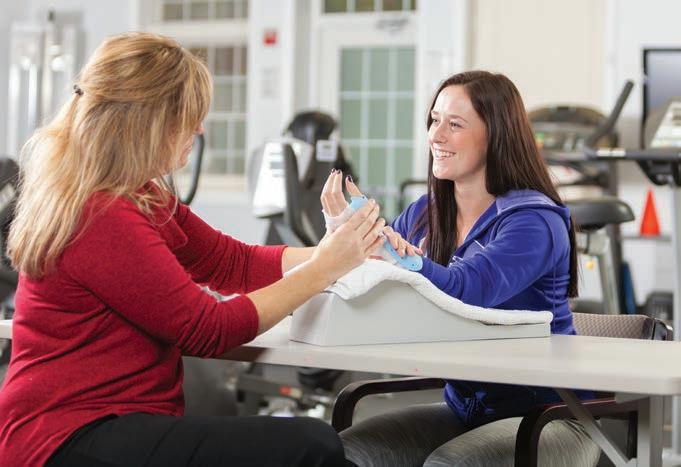
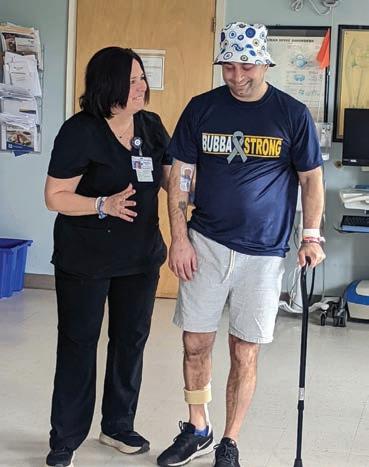
We have been supporting them for so many years because it allows us to show our gratitude for the outstanding work they do there.”
According to Hospital President Jim O’Connor, “We are so appreciative of the role of philanthropy in helping us stay at the forefront of excellence in rehabilitation. It is incredibly special and meaningful to partner with the community to care for our most vulnerable.”
“
Why I give… St. Charles has been important to me and to my family for many years. We have experienced life’s highs and lows within its walls. In fact, all three of my children were born there. The ongoing strength of the hospital is something my family and I care deeply about, so supporting the Emergency Department in memory of our parents was an easy choice for us.”
St. Francis Hospital & Heart Center now has the honor of having an endowed chair, made possible by The Peter & Jeri Dejana Foundation.
The chair position, called the Dejana Family Endowed Chair in Clinical Leadership, is held by Stefan Muehlbauer, MD, PhD, Associate Chief Medical Officer and Chair of Emergency Medicine at St. Francis.
The role of endowments
Within clinical medicine, endowments provide long-term financial support for specific initiatives, positions,
programs or research. Chair holders are able to spend more time with patients and pursue initiatives such as teaching and research to improve care services at their hospital. Endowed chairs are the highest honor for recognizing a physician’s dedication to their clinical work and exceptional contributions to patient care.
Dr. Muehlbauer plans to use his time as endowed chair to further research his passion for infectious disease management and sepsis control. He plans to attend medical and research conferences more
Pat Reimerdes, supporter of St. Francis Hospital & Heart Center
frequently, both to present on St. Francis Hospital’s outstanding services and to bring best-in-class practices back to St. Francis on an ongoing basis.
Endowed chairs are funded through donations that establish the principal of the endowment. While the principal remains untouched, the investment returns it earns can be used as a consistent revenue stream for the hospital.
Senior leadership at St. Francis Hospital & Heart Center is eager to give other skilled
physicians the chance to hold endowed chair positions.
A special connection
The Dejana family has had a special relationship with Dr. Muehlbauer for several years. After a long illness and multiple visits to St. Francis, Mr. Dejana passed away in 2024 at the age of 84. He had been a St. Francis benefactor for some time.
“Dr. Muehlbauer is an extraordinary person and an outstanding physician, and he was with us every step of the way during my dad’s illness,” said Tyler Dejana. “I know
“ Why I give… Donating is my heartfelt way to express deep gratitude for the compassionate, life-changing care provided by the incredible doctors and staff, with whom I’ve built a meaningful connection, while also supporting the hospital’s beautiful mission to deliver healing and hope to our community. It’s a true privilege to give to such a dedicated institution.”
that having our name associated with this chair would be deeply meaningful to him and that my dad would be so pleased to know it will provide support to Dr. Muehlbauer for many years to come.”
Charles Lucore, MD, MBA, President of St. Francis Hospital & Heart Center, said that the implementation of an endowed chair is among the highest honors a physician can receive. “Dr. Muehlbauer’s dedication to patient care and clinical excellence exemplify the central tenets of leadership at St. Francis,” he said. “This endowment will further support him in his efforts to ensure the best possible outcomes for every patient who comes through our Emergency Department. We are very grateful to the entire Dejana family for making this possible.”
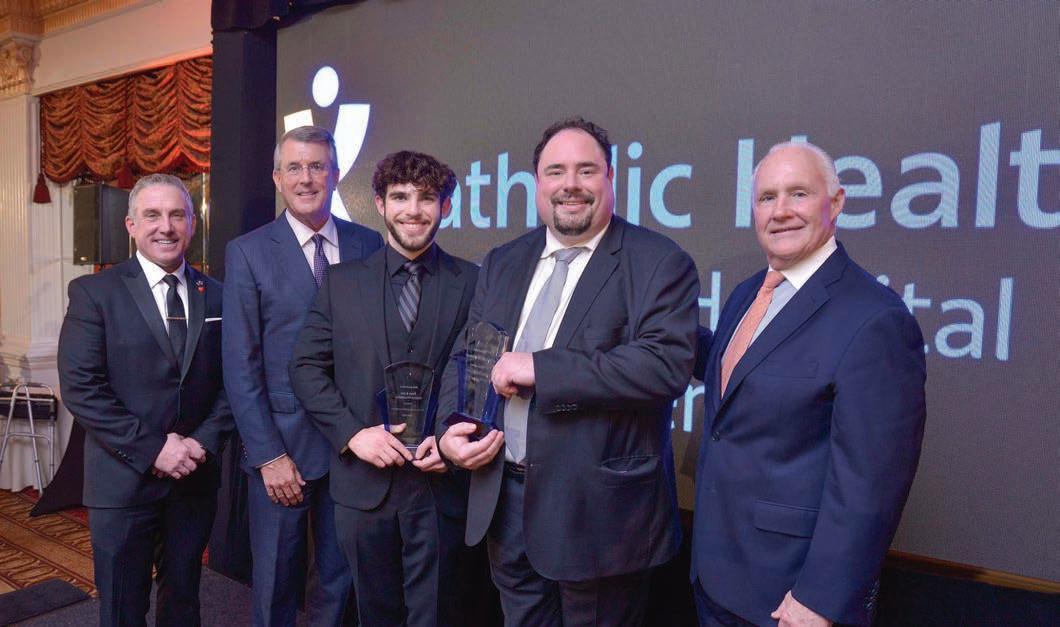
St. Francis Hospital is synonymous with their “Heart Center” and remains the only specialty designated cardiac center in New York State. As Long Island’s most-awarded heart program, St. Francis Hospital has assembled a team of highly-recognized experts to work under the leadership of Dr. Richard A. Shlofmitz, System Chair of Cardiovascular Services, Catholic Health and Chair of Cardiology, St. Francis Hospital & Heart Center.
Since the hospital’s founding more than 100 years ago, philanthropy has driven advances in clinical care, research and education. In fact, research is a cornerstone of St. Francis Hospital’s reputation for innovation and leadership in the field of cardiovascular care.
To support the cardiac team’s ability to drive the development of new therapies, St. Francis Hospital created the Cardiology Innovation Research Fund to guarantee that resources are perpetually available for high-level training and leadingedge research.
Advances made in just a few short years under the endowment include new gold standards for intracoronary imaging and techniques related to Percutaneous Coronary Intervention (PCI), which uses catheters to clear arterial blockages in a minimally invasive way. As a result, St. Francis Hospital was among the first to use Optical Coherence Tomography (OCT), providing three-dimensional views of the heart’s vessels in real-time. Previously, this procedure relied heavily on a physician’s estimations. With the information gathered from
Lauren and John Keogh, supporters of St. Francis Hospital & Heart Center
“ Why we give… For generations, our community has been well served by the expert care delivered across Catholic Health, which we both experienced growing up ourselves and then raising our children here on Long Island. It is rewarding for us now to be part of the effort that will shape the next generation of care through research and innovation.”

Dr. Richard Shlofmitz presents at the OPCI Conference
OCT, an interventional cardiologist tailors each patient’s treatment plan far more precisely, resulting in better long-term cardiac health.
Dr. Shlofmitz, along with Dr. Ziad Ali and their team have created a global educational program known as Optimizing Peripheral and Cardiac Interventions (OPCI), featuring faculty from around the world. The OPCI program provides training via live, real-time surgical procedures. “I have had a front row seat to the growth of St. Francis Hospital’s cardiovascular specialties since the late 1980s, when Dr. Shlofmitz provided life-saving care to both of my parents,” said Matthew Serra, former board member. “Since then, thousands more patients, including me, have experienced his kindness and compassion, alongside his
world-renowned expertise. The reach of Rich and the St. Francis Heart Center team now goes far beyond Catholic Health and proves the value of investing in clinical education, research and innovation. It’s the difference we make today that ultimately defines the quality of care we can depend on for many years to come.”
Ronald Steinlauf and his wife Allyson also understand how important it is to support the Cardiology Innovation Research Fund. “This fund is essential so that the team Dr. Shlofmitz has assembled can continue to make a global impact in shaping therapies of the future,” said Steinlauf. “There is no doubt in my mind that the Cardiology Innovation Research Fund is paving the way for the cardiac breakthroughs of the future.”
St. Francis Hospital & Heart Center is taking its reputation for cardiovascular excellence beyond the confines of its hospital-based operating rooms and cardiac catheterization labs, as it opens a new chapter in advanced outpatient care.
The hospital recently completed major renovations at its auxiliary campus at 2200 Northern Boulevard in East Hills to extend St. Francis Heart Center’s cardiovascular services and imaging. With philanthropic support driving the project, the East Hills site will provide thousands of cardiac patients a convenient outpatient setting for heath checks, tests, diagnostic imaging and everything in between.
This new location is comprised of two key areas: cardiology outpatient specialties and sub-specialties and a dedicated cardiac imaging center, made possible by the DeMatteis family. Together, they bring 40 St. Francis physicians from the main St. Francis Hospital campus to a new space that optimizes patient care with centralized reception, waiting and support resources. The Imaging Center provides advanced diagnostic imaging
including a SPECT scanner, a PET scanner, eight echo rooms and more.
“St. Francis Hospital & Heart Center is already a world leader in cardiac care,” said Richard DeMatteis, whose family has been involved with St. Francis for decades.
“The DeMatteis family is proud to continue supporting the hospital as it modernizes and expands.”
Richard and his siblings Linda Langer, Scott DeMatteis and Tracey DeMatteis, the family Trustees of the DeMatteis Family Foundation, directed a generous commitment to support the dedicated Cardiac Imaging Center at East Hills.
This new location also addresses the growing number of patients who are able to return home the same day of their procedure, including cardiac catheterization.
Approximately one-fourth of St. Francis echocardiograms are currently performed in the
outpatient setting, with that percentage likely to increase as ambulatory care expands in support of St. Francis Hospital’s cardiac patient care.
St. Francis Hospital Foundation Board member Bob Catell is among the early supporters of an effort to extend St. Francis Heart Center, inspired by its far-sighted
vision. “The new space provides a state-of-the-art environment that not only accommodates the current physicians and staff, but also anticipates future growth in cardiology, structural heart, cardiac surgery and vascular medicine,” said Catell. “St. Francis is not just leading today, but far into the future.”
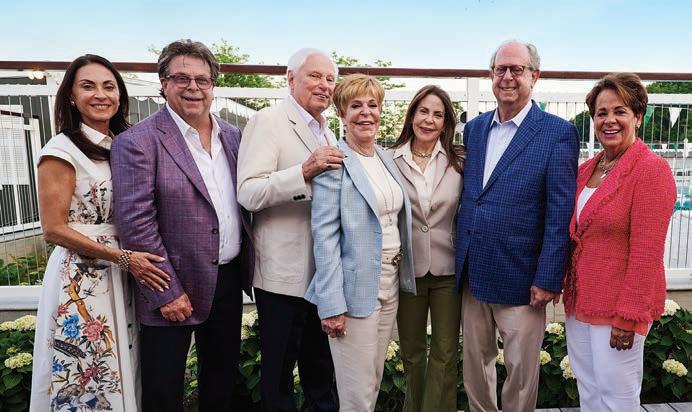
St. Joseph Hospital has been serving the community for nearly 70 years. Originally called Mid-Island Hospital when it opened in 1955, then renamed New Island Hospital in 1999, it finally became a part of Catholic Health in 2010 and was renamed St. Joseph Hospital. In the 15 years since acquiring the hospital, St. Joseph leadership has continually upgraded equipment and renovated spaces to elevate care in the community it serves.
Through philanthropic partnerships, St. Joseph has been able to purchase and implement state-of-the-art technology, including the MicroAire Power Assisted Liposuction System and LipoTower to aid breast reconstruction surgery patients as well as those having bariatric surgery. These innovative tools and equipment allow surgeons to safely meet an increased need for complex procedures, while fostering shorter recovery times with less bruising, swelling and trauma.
“This is an important project for us to be involved in,” said Bob Brull, President of The Marilyn Lichtman Foundation. “The advanced technologies we help to fund are
helping St. Joseph Hospital deliver advanced treatment to more than 500 patients each year.”
St. Francis Heart Center at St. Joseph Hospital is also using advanced equipment in its cardiac catheterization lab, which was recently upgraded to include a cardiac ablation system to support its new electrophysiology program.
“Before the catheterization lab opened at St. Joseph Hospital, patients having acute heart attacks often had to travel too far to be cared for safely,” said Dr. Howard Sussman, Chief Medical Officer at St. Joseph Hospital and President of the Harold I. and Faye B. Liss Foundation. “Having St. Francis
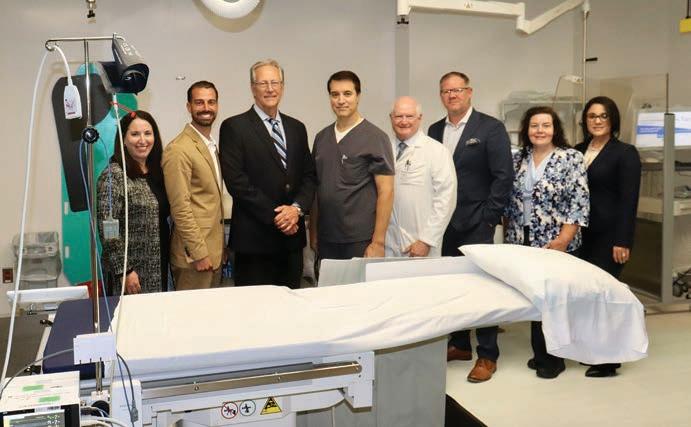
cardiac catheterization lab with St. Joseph Hospital leadership
Heart Center at St. Joseph Hospital has been the difference between life and death for those who may not have survived a longer ambulance trip. The support of our philanthropic contributors is an important part of our critical mission.” As president of the Liss Foundation, Dr. Sussman is also committed to supporting St. Joseph’s physical space and therapeutic environment.
Investing in its hospital staff is also a priority for St. Joseph Hospital. With the support of donors, St. Joseph
created a Recharge Room—a dedicated space where clinical staff get a few minutes of needed down time in a relaxing environment with scenic imagery, soothing music and calming scents. According to Wantagh resident Benno Ansbacher, “The Recharge Room creates a calming oasis where nurses, doctors, and other hospital staff can relax and relieve some stress. I feel good knowing we can support the staff who bring so much healing and comfort to others.”
When a loved one enters hospice care, the demands on family can become high. Their loved one may need help bathing, feeding and with other health-related tasks. If family lives far away, or their loved one needs round-the-clock care, many people will seek a home health aide to fill in the gaps.
Although hospice care is often covered by health insurance, some policies cover only part of the care. Also, many Long Islanders have no health insurance and cannot afford to pay out-of-pocket for the services of a home health aide.
With the help of our philanthropic partners, Good Shepherd Hospice created the Home Health Aide
Assistance Program Support Fund to allow hundreds of Long Island residents to benefit from the care of a home health aide. In fact, last year, nearly 150 people received more than 8,000 hours of care through the Home Health Aide Fund.
Dr. Jay Schachne wanted to support the fund after his own experience of watching his father enter hospice
Laura Page-Greifinger, supporter of Good Shepherd Hospice
care. “I saw firsthand the incredible impact that compassionate, skilled home health aides can have—not just on patients, but on their families,” he said. “After experiencing that level of care, I knew I wanted to give back and help ensure that others could access the same support during such a vulnerable time.”
Dr. Schachne’s father was able to spend his final days in comfort and dignity at home, surrounded by family. “The home health aides not only provided essential medical

support, but also emotional strength and reassurance. Giving to the Home Health Aide Assistance Program Support Fund is my way of honoring that care—and helping other families to receive the same gift. It’s a unique kind of support that strengthens families, eases burdens and truly reflects the values of a caring community.”
“ Why I give… I give to Good Shepherd Hospice because it gave me a place to speak and be with Mel and the family—and not taking care of Mel. Hospice also gave our family comfort to see all of the people coming to our home to be with us. Hospice personnel were the first people to ask how I was doing during the 3 ½ years of caregiving. They answered the phone at 3 am to discuss medications with me. I felt they ‘had my back,’ which was a first in the 3 ½ year journey. Hospice also gave me the gift of bereavement classes which helped me get from the ‘forest to the meadow,’ as I call it.”
Hospice isn’t a place—it’s a philosophy that recognizes the value and dignity of life.
John Ehrmann’s wife Mary Ann turned to Good Shepherd Hospice in her final days. “Everyone was exceptional to my wife when she was there,” said Ehrmann. “All of the staff, at every level, were attentive, compassionate and caring. I like to refer to them as ‘angels.’”
Ehrmann’s experience with compassionate end-of-life care is illustrative of the kind of care for which Good Shepherd Hospice is known. Good Shepherd’s vision of honoring life with compassion, comfort and dignity extends to patients of all ages, regardless of race, religion, lifestyle or economic status. Good Shepherd Hospice sees only the patient in need and the family who loves them.
Many people know that hospice care is about making a person’s remaining time comfortable and dignified, whether at home, in an inpatient unit, or in a skilled nursing or assisted living facility. Yet at Good Shepherd, hospice care extends beyond the patients themselves and includes caring for their families. In many cases, they are navigating loss for the first time.
Bereavement services are an essential component of the hospice care continuum, both before and after the death of a loved one. As inadequate bereavement support can be detrimental to the health and well-being of survivors, Good Shepherd has made it part of its mission to support families along the hospice journey.
Throughout Long Island, Good Shepherd holds multiple group
Carter Anne McGowan, Esq., supporter of Good Shepherd Hospice
“ Why I give… I give to Good Shepherd Hospice because in some of the most difficult times in life, their caregivers are truly the hands of Jesus.”
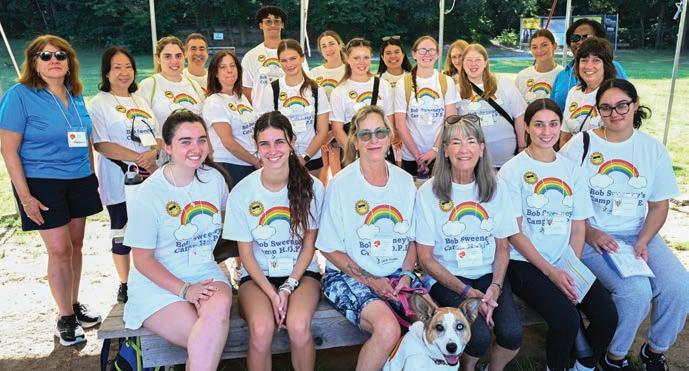
Camp H.O.P.E. Volunteers
meetings and workshops each month to support grieving family members. These workshops include traditional methods of sharing stories and talking through grief, as well as creative modalities like yoga, horticulture projects and nutritional education. Good Shepherd holds “Celebrations of Life,” biannual memorial services in each county to remember and celebrate the meaning, purpose and impact of a loved one’s life. At times, Good Shepherd also provides professional referral services for those who need services for complicated grief, mental health or other interventions for substance abuse or self-harm. Hospice bereavement services also include Camp H.O.P.E., a free, professionally-run bereavement camp for children ages 5–17 and their caregivers who have experienced the death of a close family member. Central to Camp
H.O.P.E. is its curriculum of activities and therapeutic practices that are designed to teach the children about themselves, the grief they are experiencing and how to develop resilience after losing a loved one. These services are offered in both English and Spanish, so that Good Shepherd can assist as many people as possible on their way to healing. Today, Good Shepherd Hospice’s bereavement services are supporting over 2,500 people in Nassau and Suffolk Counties.
After the loss of Mary Ann, John Ehrmann attended a bereavement group to process his experience. He said, “I am doing okay with the help of Good Shepherd’s bereavement group, hosted by Erin. Thank you for your kindness and all that you do to make the last days of a loved one peaceful.”
After a hospital stay, many people return home with insurancecovered Catholic Health Home Care assistance. A clinical expert will come regularly to assist in the patient’s medical needs, from using certain medications to monitoring vital signs. Still, the patient may find it hard to keep up with household tasks, like cleaning, doing the laundry or shopping for groceries.
That’s where the Helping Hands Program of Suffolk County comes in. The program provides non-medical support to home care patients in the Town of Southampton. This can include light housekeeping tasks or running

simple errands. But perhaps most important is the impact the Helping Hands homeworker’s visits have on the patient’s spirits. Many home care patients are lonely and feel isolated. These visits do much to engage and enliven the patient, often accelerating the healing process. Helping Hands visits may take place once or twice a week.
The program is provided at no charge for those who cannot pay, while others contribute on a sliding scale. In 2024, four parttime homeworkers made over 1,200 visits to 71 clients, up 6% in clients served from 2023. In 2025, the goal is not only to reach even more clients, but also expand the current coverage area to include East Hampton and Montauk.
The Helping Hands Program in Suffolk County began in 1994 and has operated under Catholic Health Home Care since 2018. It is supported through philanthropy and client contributions, with support from groups like the Bridgehampton Association and Southampton Bath & Tennis Club.
“For our local residents who need extra help around the home while facing medical issues, the Helping Hands Program provides wonderful assistance,” said Blair Fiore, President of the Bridgehampton Association. “Helping Hands workers also provide welcome social contact for those who must remain at home and may feel isolated.
The Bridgehampton Association is proud of our long-term support of this program vital to the people of Bridgehampton.”
Another supporter of the Helping Hands Program is the Southampton Bath & Tennis Club. The Charitable Fund Committee states, “We are
Bob Brull, President, The Marilyn Lichtman Foundation, supporter of Home Care
“
Why
I give… We support Catholic Health Home Care because investing in nurse training and professional development directly improves patient outcomes and strengthens the future of home-based care. These programs empower nurses with the skills and confidence they need to deliver high-quality, compassionate care to some of our most vulnerable neighbors.”
excited to support the Helping Hands program, which empowers older adults in our community to live independently while supporting their medical needs. Their efforts create a profound and lasting positive impact.

Peggy Maher, Chief Development Officer
“Giving back” is a uniquely human act that affirms our values and strengthens social bonds.
As the head of fundraising for Catholic Health, it is my privilege to work with individuals and families from all across Long Island who want to support our outstanding physicians, nurses and staff. This work gives me a window into the many facets of gratitude that inspire acts of philanthropy. From the birth of a grandchild to a life-saving procedure to the passing of a beloved parent in the care of our hospice programs, Long Islanders have a multitude of reasons for wanting to give their support to our work at Catholic Health. Without exception, it is always an honor to accompany our patients through those deeply personal life experiences and to witness their generous desire to give back.
The act of giving is inherent to human relationships. It is an expression of gratitude and trust that strengthens social cohesion. Giving affirms our values and speaks to what is most important to us in life. No matter the amount, a gift of support is a vote in favor of community and connection. I hope the stories shared in this year’s Impact Report convey not only the generosity of Long Islanders toward Catholic Health, but also the enduring bonds of trust, friendship and gratitude this giving represents.
Thank you for choosing to be such a vital part of our community and for your commitment to our shared humanity.